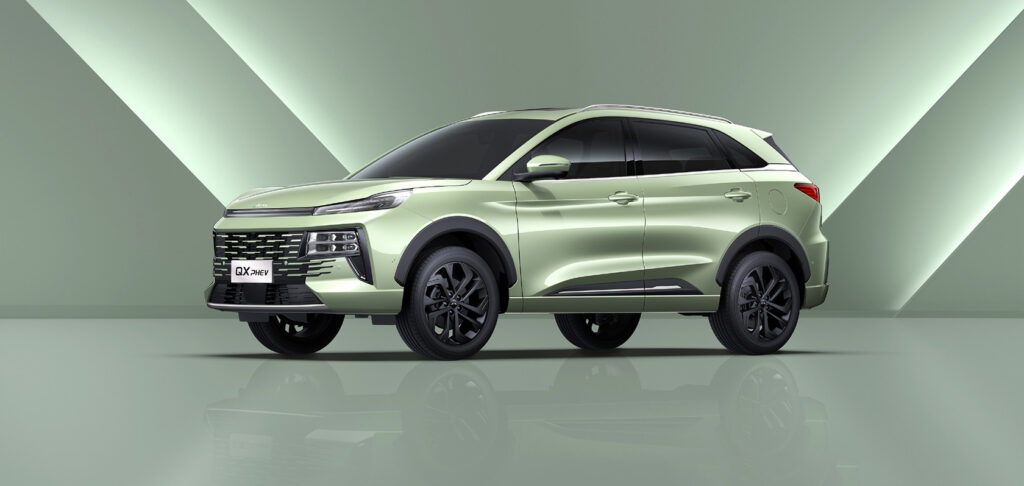
Founded in 1964, JAC Motors has evolved over more than 60 years from a single commercial vehicle manufacturer into a global automotive group covering all vehicle categories. It has established four core business segments: traditional fuel and new energy powertrain vehicles, core components, automotive mobility, and automotive services. The company is committed to building a comprehensive automotive service platform encompassing the entire ecosystem, supply chain, and value chain. To date, JAC Motors has adopted a core strategy of “electrification, intelligence, connectivity, and ecologization.” Facing the continuous advancement of the new energy wave, the company has completed its technical roadmap for pure electric and hybrid vehicles, with PHEV models becoming the key vehicle for its technological breakthroughs. JAC Car contributes to society through continuously improving products and services, and creates wealth for society through sustainable and steady development.
The main production plant for JAC PHEV models is located in Hefei, Anhui Province. As the core of JAC Motors’ global strategy, it has formed a coordinated layout of “one headquarters and multiple plants.”The production headquarters is primarily responsible for JAC Motors’ strategic command and overall vehicle integration and research and development. It leads the architectural design and technological iteration of PHEV models. It is equipped with China’s first all-aluminum body production line, with the stamping workshop utilizing German Schuler high-speed presses, achieving precision with an error margin of only 0.01mm. The welding workshop features 100% mechanized fully automatic welding, with the key welding strength compliance rate of vehicles reaching 99.9%. The remaining production sites include the Yangzhou base and the Liuzhou base, among others. These regionally distinctive production bases leverage the logistical advantages of the Yangtze River Economic Belt and export hubs to swiftly respond to market demands, thereby optimizing costs to achieve synergy between production technology accumulation and production capacity. In addition to its production bases in China, JAC Motors also has its own production plants overseas. The Mexico plant is JAC’s core facility in Latin America, equipped with a warehouse capable of storing 500,000 vehicle parts, ensuring that after-sales response times are reduced to within 48 hours; JAC automobiles’ CKD plant in Kazakhstan covers the entire industrial chain, from vehicle parts production to vehicle assembly and after-sales service, all of which have been localized. JAC Motors’ joint venture plant with Vietnam’s Changhai Automobile Group can produce certain models tailored to the high temperatures of Southeast Asia, and the products manufactured at the plant can be distributed to markets such as Thailand, Indonesia, and Singapore.
In addition to global production, JAC vehicles has also established a global R&D system, achieving parallel development of technological synergy and innovation-driven growth. JAC Motors’ R&D headquarters in Hefei, China, has a national-level enterprise technology center, an industrial design center, and 12 specialized laboratories for whole vehicle collision, NVH, and environmental durability testing. It is also responsible for developing honeycomb battery technology and three-in-one electric drive systems, with more than 30,000 industry patents applied for to date. The Japan Design Center is primarily responsible for the benchmark model design of the JAC Refine S3 and Junling V series. The Italy Design Center focuses on vehicle styling and aerodynamic optimization, forming a closed-loop chain with the Japan Design Center. The Silicon Valley Innovation Center is primarily responsible for intelligent driving and vehicle-to-everything (V2X) technology, collaborating with some tech giants to build an intelligent ecosystem network.

The main advantages of JAC PHEV models include:
Currently, JAC PHEV’s models on sale include: JAC RF8 PHEV, JAC JS6 PHEV, JAC T9 PHEV, and JAC QX PHEV.
The JAC QX PHEV is a highly cost-effective electric SUV model, with a pure electric range of 120 km and a maximum combined range exceeding 1,300 km. Although it is a plug-in hybrid vehicle, the overall driving experience of the JAC QX is virtually indistinguishable from that of a pure electric vehicle. It accelerates from 0 to 100 km/h in just 7.3 seconds, and its drag coefficient while driving is as low as 0.3 Cd. The interior features a 12.3-inch dual-screen design, paired with the latest generation of iFlytek’s XTTS 3.0 voice interaction system and Huawei HiCar, ensuring smooth connectivity with smartphones and 5G networks, significantly enhancing the user experience. The front of the JAC QX PHEV features a traditional closed grille combined with split LED headlights, while the unique front bumper airflow channel design enhances the vehicle’s sporty appeal. The floating roof and hidden door handles on the sides give the vehicle a distinctive tech-forward aesthetic. When the rear lights are illuminated, they create a “light blade” effect that echoes the front fascia, while the diffuser design on the rear bumper emphasizes the performance attributes of the hybrid model.
Over the years, JAC Motors has won numerous awards and honors for its outstanding vehicle quality and strong technical capabilities. JAC car company has been listed among the BrandZ Top 50 Global Chinese Brands for four consecutive years and has also won multiple China Automotive Industry Science and Technology Awards. Looking at its globalization process, JAC Group has established six overseas subsidiaries around the world and has exported more than 1.5 million vehicles, gaining widespread recognition from consumers globally.
JAC motor company is not only a traditional fuel vehicle manufacturer, but also an important force in the new energy transition wave, committed to providing global users with PHEV vehicles that combine performance and a green travel experience. In the future, JAC will continue to uphold its mission of providing users with the best travel solutions to drive the world forward.